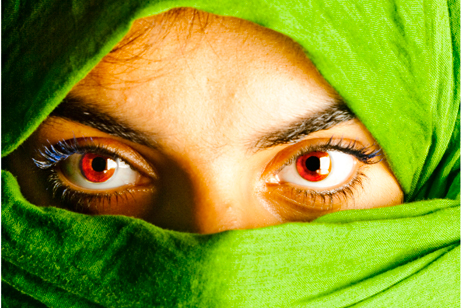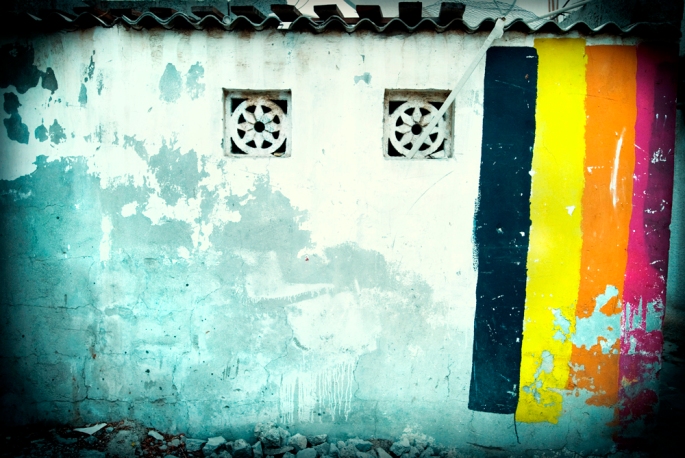Nick Leech speaks to Shammi Samano and Asma Al Kendi, the founders of a new online gallery that’s dedicated to breaking down cultural barriers by bringing art from the Gulf region to a wider audience
“The Girls of Dubai are here!” proclaims Gulfography, a new website and online gallery that’s dedicated to showcasing work by emerging and established artists from the UAE and the wider Gulf region. It’s a loud statement designed to capture the attention but, like so much of the work exhibited on the website, it also contains an ambiguity that forces the viewer to look more closely and reconsider what they think they now about life in the Gulf.

Amina Taher’s self-portrait ‘Power Eyes’ is a case in point. From behind an uncharacteristically green shayla a pair of fiery eyes confront the viewer’s gaze, challenging you to look away or to fathom the picture’s meaning. The image lends itself to a heady mix of possible interpretations, about gender, the veil, and sexual inequality, but for its creator it remains a profoundly personal statement. “Even though I am covered, when you look at my eyes, you can see how I feel inside. If I am in love, or I am sad, or I am happy. That picture describes me, Amina Taher.”
Taher’s self-portrait is one of a set of images on Gulfography that are selected from Privately, a 2010 exhibition that showcased the work of eighteen applied communications students from Dubai Women’s College. The show attracted large numbers of visitors and substantial attention from the media, and provided its curator, the Iraqi-born artist and filmmaker Shammi Samano, with the inspiration for Gulfography. “I realised there was an empty space. Local photographers, especially women, were expressing themselves in interesting and provocative ways with subject matter that was quite different from the themes you traditionally see in local photography.”

For Samano, Privately had provided an eloquent and challenging insight into the lives of young women in the UAE, an experience defined by “a desire for more freedom, for more power, loneliness, wanting to talk but not feeling like you could, feeling trapped by judgements.”The show also introduced Samano to her fellow Gulfography co-founder Asma Al Kendi, an Emirati and Dubai Women’s College alumnus with a bachelor’s degree in computer science. Gulfography is the result of their collective passions, skills, and desire to provide a platform for artists who felt intimidated by the art world and traditional gallery system.
“A lot of work ends up on Facebook and Flickr. You find gems or particular photographers who are doing really interesting work, but there was no space for it. That was the tragedy. These people are artists with something to say and with a sound aesthetic vision and they should have somewhere that’s professional to display and that’s more global than a physical space.”

Samano’s assessment is borne out by the artists themselves. Asma Faisal is another graduate from Dubai Women’s College whose work now features extensively on Gulfography. “I think the initiative that Shammi took provides amazing support for us. Gulfography is the first time I’ve published my pictures. I never showed people my photos before, I just took them and kept them for me. To showcase my photos outside of my family and friends was a huge step.”
If Gulfography is the product of Samano and Al Kendi’s vision, it also results from their experiences as women from the Middle East who now live in the West. For Samano, this factor played an important role in encouraging her to “do something that connects to our culture but which also speaks to the West and opens up a dialogue.” For Al Kendi, inspiration came from the ignorance and widespread misconceptions about the UAE that she encountered outside the region.
“When I arrived at San Francisco airport, the first thing the passport control officer asked me was ‘Where is your burqa? Where is your camel? Are you allowed to travel without a man?’ Nobody knows about the local artists here who are ambitious, bold, and strong and who want to send a message that we are a creative and educated people. We are not violent or oppressed. I wanted to represent something about the area that I came from and I wanted people to know that there is more to Dubai.”

For Samano and Al Kendi, it was important to create an online gallery that would provide an international platform for artists from the Gulf however, exhibitions and physical work play an important role in their plans for Gulfography’s future, as Samano explains. “Physical exhibits will always be a part of what Gulfography is about. The physical and the virtual have to work together and even though the images look great online, there’s nothing like seeing a physical print on paper, exhibited in a gallery space. It’s its own kind of experience.”
Samano and Al Kendi are currently in the process of planning the first Gulfography exhibition in the West. This will see the work of young female photographers from Dubai, as well as the noted Yemeni photojournalist Amira Al Sharif, exhibited in a gallery in San Francisco in late October and longer-term plans include the production of a book however, Samano and Al Kendi are keen not to place any restrictions or limits on Gulfography’s future. Al Kendi repeatedly refers to ‘the bigger picture’.
“We’re not just trying to sell and showcase art. We’re trying to build a bridge between the West and the East and we’re sending different messages to people who don’t know anything about the Gulf region. We’re trying to connect this side of the world with the other.”
Samano and Al Kendi are also keen to expand Gulfography’s scope beyond photography, and to show work by male artists, by expats from the Middle East diaspora, as well as foreign expats with experience of life in the Gulf. To that end, Samano is currently developing an exhibition entitled Expat Mirages with a female Western expatriate who has lived in the UAE. “The expat experience plays a large part of the story of the Gulf” says Samano, “it’s its own story and its own thing.”
Other artists currently featured on Gulfography include Alia Al Falasi, Atiya Al Marri, Azza Al Owais, Reem Al Falahi, and Roudha K. Al Shamsi. For more information, or to view/purchase images, see http://www.gulfography.com. Prices start from around Dhs550.
This article originally appeared in The National, Abu Dhabi

